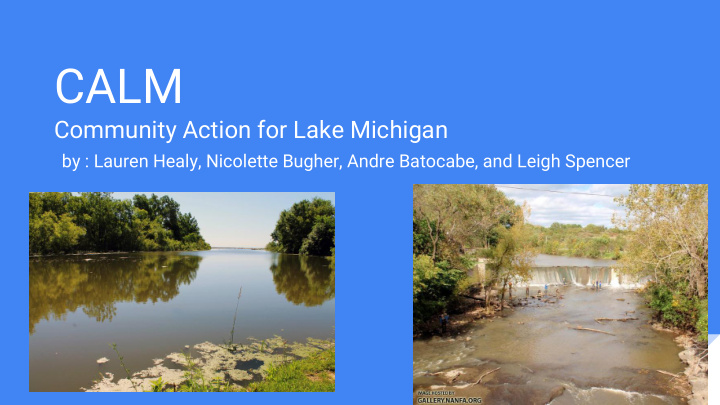



CALM Community Action for Lake Michigan by : Lauren Healy, Nicolette Bugher, Andre Batocabe, and Leigh Spencer
Mission Statement CALM’s mission is to ensure that the Root-Pike watershed meets water quality standards to a level that is safe for human use, while working towards restoring the watersheds coasts, preventing further digression, and preserving important ecosystems by 2035.
Root-Pike Water Basin Background ● Sub-watershed of Lake Michigan Water Basin ● Over 410 square miles in four counties Feeds into Lake Michigan ● Temperate climate zone ● ○ Well defined seasons 50% of the land in the watershed is used ● agriculturally, 30% of the land is urbanized ○ Led to somewhat degraded water quality
Maps Map of Root-Pike Watershed Land Use Land Cover
History ● Lake Michigan Watershed has experienced extreme changes in a short amount of time Approx. 170 years ago the terrain consisted of lush forests and wetlands ● and water ○ Favorable terrain conditions led to the first attempts of settlement Native American villages sprouted in and around the watershed due to the ● proximity of supply water. ● First European settlement, “The Village of Pike River” formed in 1835
History Continued ● Pike River was one of the first rivers to be dammed & ditched for drainage and irrigation Extreme shoreline disruption seen throughout the rivers ● ○ Historical common practice of clearing land to the very edge of the rivers
Governance ● Great Lakes Water Quality Agreement ○ Us & Canada cowork to identify issues and find solutions Lake Michigan Lakewide Action Management Plans ● ○ Major groups focused on increasing water quality within The Great Lakes Smaller scale watershed groups ● ○ Root-Pike Watershed Initiative Network (Root-Pike WIN)
Root-Pike WIN ● Cooperative effort with Wisconsin Department of Natural Resources ○ 401c3 non-profit Educational programs, monitoring projects and river restoration ● ● EPA-approved nine key Pike-River Plan ○ Nine highlighted issues including ■ Phosphorus and nitrogen from farming ■ E. Coli and pathogens from agriculture and storm water run-off ■ Chlorides from road salts ■ Invasive and non-native species
Problems 1.) Pollution 2.) Erosion 3.) Invasive Species
Problem 1: Pollution PCBs & E coli ● PCBs ● E coli ○ Banned in 1979, currently residuals from past usage ○ Harmful gut bacteria, often found in untreated sewer Health risks: neurological disorder, reproductive water ○ toxicity, endocrine disruption, cancer, and deformity ○ Health risks: severe abdominal illness, especially in ○ Spread to surrounding communities easily because of young or elderly people high transportability ○ Overflow from storm and waste-water PCBs are bioaccumulative, able to form strong bonds Concern for recreational beach use ○ ○ with soil and sediment, highly transportable, and resistant to biodegradation ○ High transportability makes PCBs threat to surrounding communities ○ Transitions from sediment to water to air Fishing industry is threatened because of ○ PCB contaminated fish ○ Hurts the economy
Problem 1: Solutions ● PCBs ● E coli ○ PCBs have high sorption to soil/sediment matrix 15 year study shows levels are high but currently ○ Dredging contaminated soil and storing at confined ○ declining disposal facility ○ Invasive species of mussels is partly responsible for ○ GAC filtration systems can help reduce PCBs levels in decline in E coli populations, more on that later contaminated water Investing in wastewater and stormwater treatment ○ ○ Sand grooming and gull reduction, helpful at local beaches but not larger areas ○ Most issues are at beaches
Problem 2: Streambank, Streambed, and Shoreline Erosion Issue: Shoreline Erosion ● Attributed to rising waters, channelization, and stream bank construction ● Decreases shorelines integrity ● Sediment deposits downstream Displaces and harms aquatic environments ● ● Reduces water quality
Problem 2: Solutions Solution 1: Bioengineering Solution 2: Buffer Strips Solution 3: Restoration ● Log placement/removal ● Strips of vegetation on either ● Sediment management side of waterway ○ Gravel reinstatement ● Long rooted plants ● Improve water quality ● Natural restoration ● Temporary rock placement ○ Natural Meander Pattern (riprap) ● Offer Stream Protection ● Enhance habitat ○ Source of food, nesting, shelter Public Outreach and Government enforcement
Problem 3: Invasive Species Issue: Solutions: Non-native plant and animal species - Implement and uphold pesticide/ invade the ecosystems of the watershed. molluscicide usage to manage aquatic This leads to a decrease in biodiversity, species depleted water quality, unnatural wetland/ - Poison and manually remove plants by coastline structure, and native specie professionals for large scale issues, death. and by community members for small scale infiltration - Continue to search for best management practices - Uphold preventative measures for other potential invaders - Reintroduce/ aid native species in population growth - Inform and incentivize public involvement - Maintain or improve population levels
CALM Goals & Conclusions Goals: Improve water quality ● ○ Implement filtration infrastructure and sediment dredging ● Restore stream banks and prevent erosion Bioengineering and restoration ○ ● Prevent invasive species and boost livelihood of native species ● Implement solution by 2035 Comply with Root-Pike WIN ● Encourage public outreach ●
Recommend
More recommend